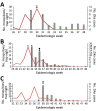Mosquito Control Activities during Local Transmission of Zika Virus, Miami-Dade County, Florida, USA, 2016
- PMID: 32310079
- PMCID: PMC7181917
- DOI: 10.3201/eid2605.191606
Mosquito Control Activities during Local Transmission of Zika Virus, Miami-Dade County, Florida, USA, 2016
Abstract
In 2016, four clusters of local mosquitoborne Zika virus transmission were identified in Miami-Dade County, Florida, USA, generating "red zones" (areas into which pregnant women were advised against traveling). The Miami-Dade County Mosquito Control Division initiated intensive control activities, including property inspections, community education, and handheld sprayer applications of larvicides and adulticides. For the first time, the Mosquito Control Division used a combination of areawide ultralow-volume adulticide and low-volume larvicide spraying to effectively control Aedes aegypti mosquitoes, the primary Zika virus vector within the county. The number of mosquitoes rapidly decreased, and Zika virus transmission was interrupted within the red zones immediately after the combination of adulticide and larvicide spraying.
Keywords: Florida; Miami-Dade County; United States; Zika virus; birth defects; flaviviruses; mosquito control; mosquitoes; vector-borne infections; viruses; zoonoses.
Figures




References
MeSH terms
LinkOut - more resources
Full Text Sources
Medical

